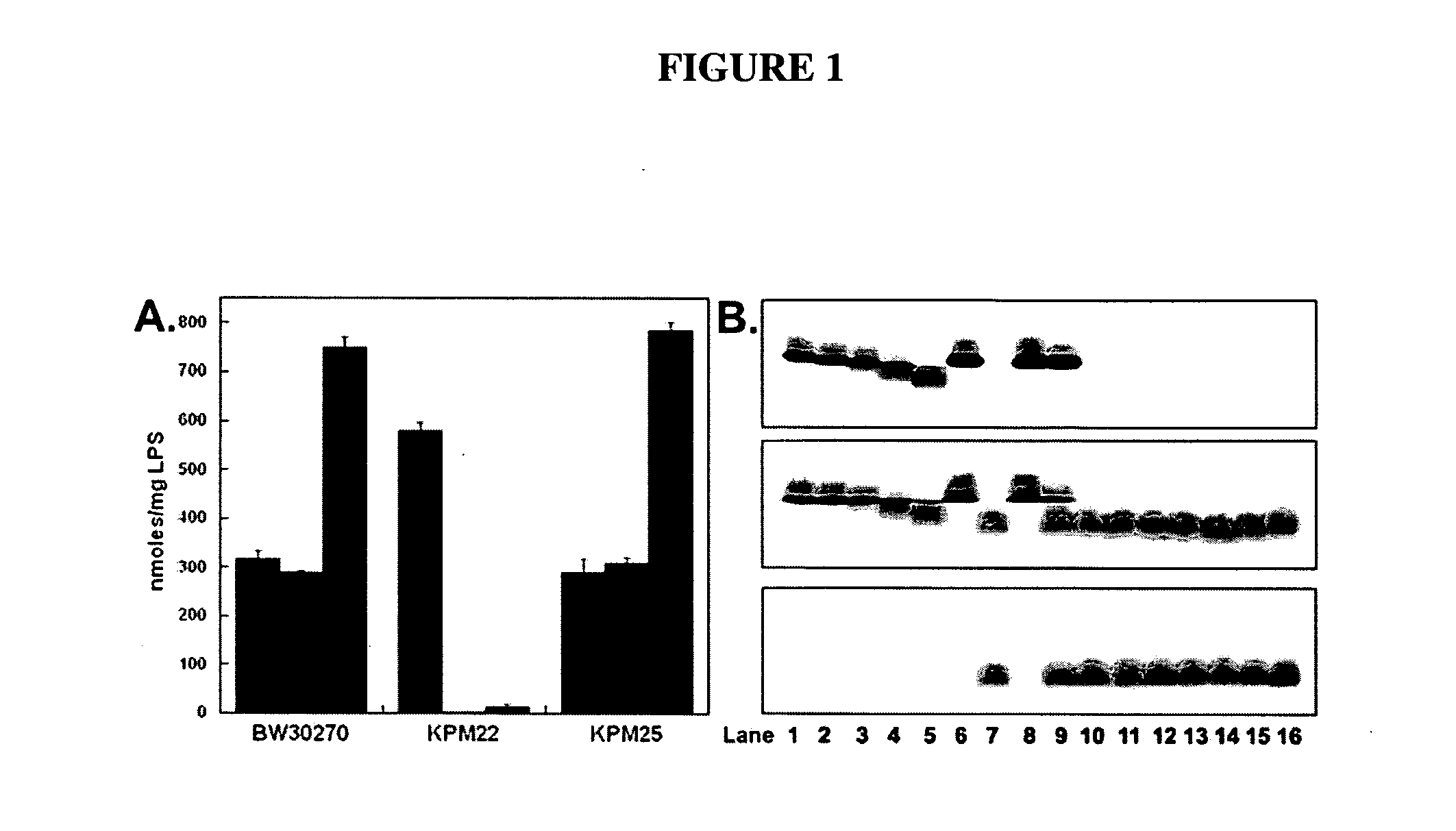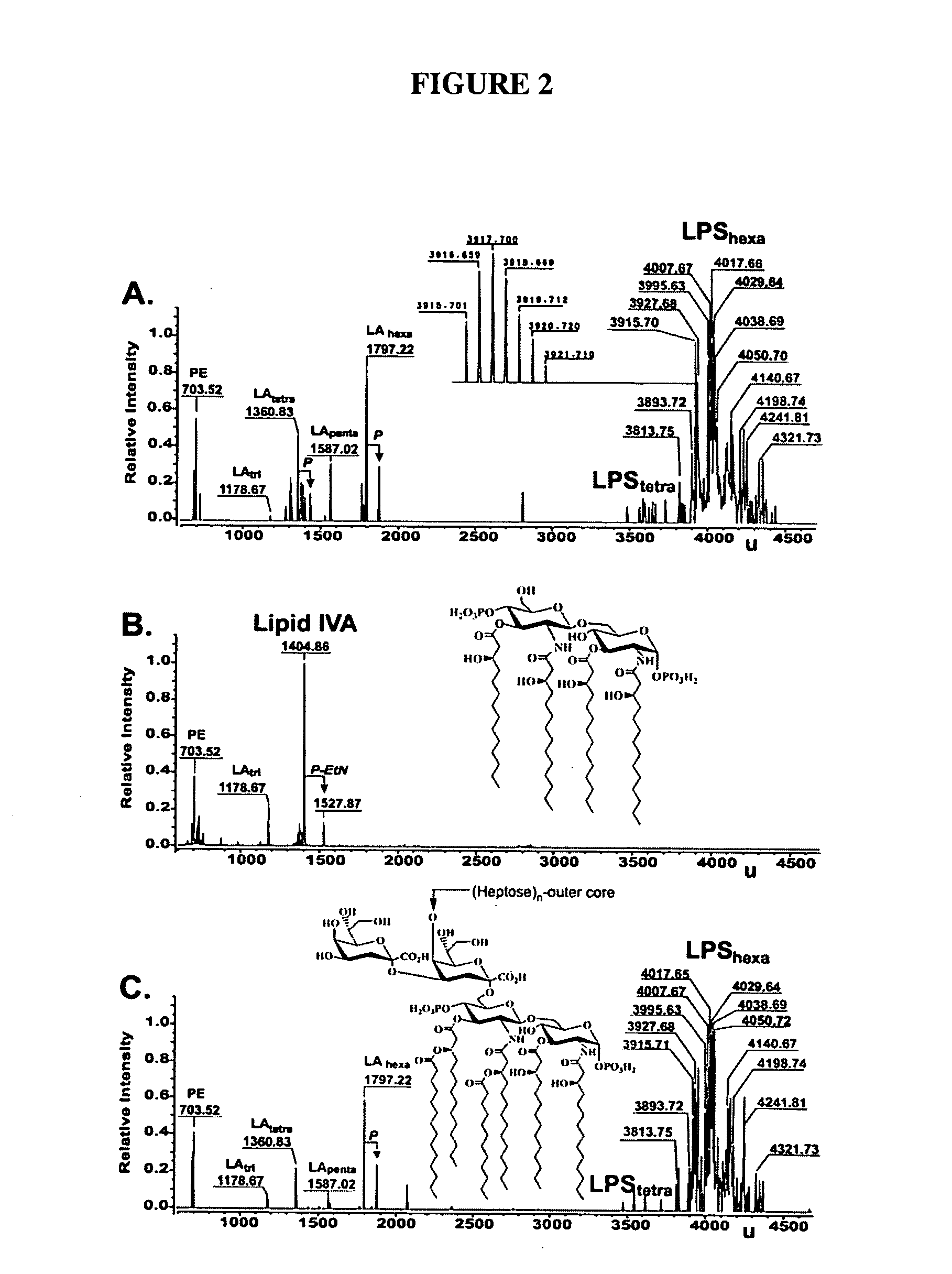Viable non-toxic gram-negative bacteria
a non-toxic, gram-negative bacteria technology, applied in the direction of antibacterial agents, drug compositions, antibacterial ingredients, etc., can solve the problems of insufficient supportive therapy, endotoxin-related mortality remains a significant problem, and the host has fatal consequences
- Summary
- Abstract
- Description
- Claims
- Application Information
AI Technical Summary
Problems solved by technology
Method used
Image
Examples
example i
[0078]This example describes the ΔAPI mutants TCM15 and KPM22. An auxotrophic ΔAPI mutant with both G-API and L-API deleted, TCM15, was constructed which became dependent on exogenous A5P for growth in accordance with the established KDO2-lipid A dogma for E. coli. TCM15 was incapable of forming colonies on solid media, regardless of the growth media, incubation temperature, or time without including A5P. When cultured in liquid MOPS-minimal media with 0.2% glycerol as a sole carbon source, cell division routinely resumed after a 32-48 hour lag despite the lack of A5P.
[0079]The E. coli KPM22 strain was shown to be a non-conditional ΔAPI mutant capable of sustained growth in rich media without an initial lag at 37° C. although there remained no measurable API activity in cellular extracts. As shown in Table 2, the doubling time increased to nearly twice that of the parent wild-type strain in LB media.
TABLE 2Generation Times in LB media at Various TemperaturesStrain30° C. (min)37° C. ...
example ii
[0093]This example describes the bacterial strains, plasmids, and primers used in the studies involving KPM22 and TCM15. The bacterial strains, plasmids, and primers used in the studies involving KPM22 and TCM15 are listed in Table 6.
TABLE 6Bacterial Strains, Plasmids, and PrimersStrain / Plasmid / PrimerDescription aSource or ReferenceBW30270E. coli K-12 MG1655; rph+ fnr+E. coli Genetic Stock Center(CGSC#7925)SL3749S. enterica sv. Typhimurium (rfaL446,Salmonella Genetic Stock CenterRa chemotype of LPS)(SGSC#228)SL3750S. enterica sv. Typhimurium (rfaJ417,Salmonella Genetic Stock CenterRb2 chemotype of LPS)(SGSC#229)SL3748S. enterica sv. Typhimurium (rfaI432,Salmonella Genetic Stock CenterRb3 chemotype of LPS)(SGSC#227)SL3769S. enterica sv. Typhimurium (rfaG471,Salmonella Genetic Stock CenterRdl chemotype of LPS)(SGSC#231)SL1102S. enterica sv. Typhimurium (rfaE543,Salmonella Genetic Stock CenterRe chemotype of LPS)(SGSC#258)TCM15BW30270(ΔgutQ ΔkdsD); A5PT. C. Meredith and R. W.auxotrophW...
example iii
[0094]This example describes the growth of KPM22. Growth of KPM22 involved exponentially dividing cultures of TCM15 in MOPS-minimal media supplemented with 10 μM D-glucose 6-phosphate and 15 μM D-arabinose 5-phosphate at 37° C. were diluted (1:200 v / v) into the same media lacking the sugar phosphate supplements. After an initial lag lasting from 24-32 hours, growth resumed and cultures were colony purified on LB agar plates.
PUM
| Property | Measurement | Unit |
|---|---|---|
| Temperature | aaaaa | aaaaa |
| Volume | aaaaa | aaaaa |
| Volume | aaaaa | aaaaa |
Abstract
Description
Claims
Application Information
 Login to View More
Login to View More - R&D
- Intellectual Property
- Life Sciences
- Materials
- Tech Scout
- Unparalleled Data Quality
- Higher Quality Content
- 60% Fewer Hallucinations
Browse by: Latest US Patents, China's latest patents, Technical Efficacy Thesaurus, Application Domain, Technology Topic, Popular Technical Reports.
© 2025 PatSnap. All rights reserved.Legal|Privacy policy|Modern Slavery Act Transparency Statement|Sitemap|About US| Contact US: help@patsnap.com



